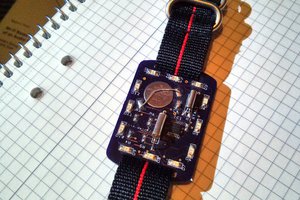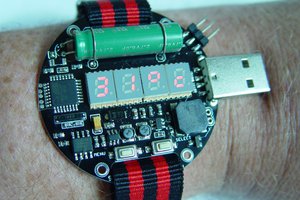Lumos - Spotlight Drone
A GPS controlled Spotlight Drone
A GPS controlled Spotlight Drone
To make the experience fit your profile, pick a username and tell us what interests you.
We found and based on your interests.
|
Adobe Portable Document Format - 2.83 MB - 11/09/2019 at 21:49 |
|
|
|
Adobe Portable Document Format - 3.33 MB - 07/06/2019 at 21:24 |
|
|
Bellow is Basic calculations of thrust for the RS1106 Motor and Prop Combo.
The single 18650 or Dual 18650 will be boosted up to the Desired voltage using 2-3 XL6008E1 running in parrell to achieve desired voltage.
\\————-————————————————————
Power of a Single 14500 is ~2.6W (~ 3.7V * 0.7Ah)
Power of a Dual 14500 is ~5.1W (~ 3.7V * 0.7Ah)
Power of a Single 18650 is ~9.25W (~ 3.7V * 2.5Ah)
Power of a Dual 18650 is ~18.5W (~ 3.7V * 5.0Ah)
\\————-————————————————————
The weigh of motor, 4x Servos, ESC, LED and 1x 14500 is 86g
(20W Flight + 10W led => 5.2 min flight time
The weigh of motor, 4x Servos, ESC, LED and 2x 14500 is 100g
(24W Flight + 10W led => 9min flight time
The weigh of motor, 4x Servos, ESC, LED and 1x 18650 is 114g
(28W Flight + 10W led => 14min flight time
The weigh of motor, 4x Servos, ESC, LED and 2x 18650 is 159g
(48W Flight + 10W led => 19min flight time
\\————-————————————————————
Using the Below Thrust tables Optimal flight time Configuration
1) Single cell 18650 Boosted to 8V
2) RS1106 (4500KV)
3) GF3020 Blade
4) 3.5A Current at 8V
Assuming no efficiency losses Flight time could be ~ 19min
Realistically flight time could be as high as 13min
Create an account to leave a comment. Already have an account? Log In.
One thing I'll note. Switching to a ducted prop/ducted fan design will increase both thrust efficiency as well as safety since it has the added benefit of keeping things out of the prop.
perhaps a version should have an option for 'hold station', so it keeps its location from point of launch, suitable for situations where a base station deployment is not feasible
I kind of have one but not functional at the moment. I am designing my new one to be a fraction of the size and utilizing pcb only construction.
Have you considered contra-rotating props, this would better balance your project and greatly retuce overcoming rotational torque. https://www.amazon.com/Brushless-Contra-rotating-CRM2413-Airplane-propellers/dp/B07D7SYPMK/ref=sr_1_28?crid=2VO1DGBSISVTK&dchild=1&keywords=contrarotating+propellers&qid=1592356416&sprefix=contra+rotating%2Caps%2C147&sr=8-28
I have a Disaster light and communications project I was searching for when I came across this as a solution
Thanks for the link was looking for something like that. I do love the simplicity of contra rotating because it takes care of both the rotational torque and more importantly the gyroscopic procession that single rotors have. That being said. Single rotors are far more efficient which is what I am aiming for. contra rotating can increase lift but to get efficient lift the would need to be 0.8-1.2 rotor diameters apart
What keeps getting updated in this project? I can't see any changes but it keeps getting bumped up the recently updated list. Also, it's submitted for the Hackaday Prize but is tagged as a shelved project. That's confusing. Nice idea though and it would be great to see some logs!
Thanks, it is an ongoing project it was shelved for a while I was changing the tags
I have been thinking about a wire antenna lifting drone. You can power through the wire. A single pair from cat5 cable is 5g/m i.e. 400g for 80m and 16ohm.
Are you taking about powering the drone through the Cat 5 cable? I think they can only handle like 15 watts or something like that.
no, when the wire is in the open air the power is only really limited by the resistance, not heat buildup. You would put ~60V in and get 30V out @3A = 95W max for a 50m single pair tether. There are better wire choices of course, I just thought of a light, easy to get wire.
Are you planning to use a separate battery for the LED? 50-100W is a fair bit and would eat into your flight time if using the flight pack.
Would the light be effective at that 200-300ft height? You wouldn't want a spot wobbling about. What kind of beam angle were you considering?
Interesting concept. I'm following.
You get more stable and lightweight structure if you put those batteries as one row so that this is longer. And then for weight reduction you can use 3 servos instead of 4. Also you can use flip blade propeller so it is more easy to carry.
I think it could fly without GPS lock for that time using barometric sensor
why not a flashlight hanging from a balloon? with the right miniturized inflation apparatus the whole unit could be the size of a 2 liter soda bottle, you could keep it in place with a piece of string. flight time probably in the weeks range, especially with solar powered flashlight
This^ I think it's a fun idea that's worth pursuing as a "can I make this work" project but I think it ends there. 13minutes isn't going to be able to do much practically whereas some sort of buoyancy-based project could get much longer time. I think you could go a step beyond balloon with string if you wanted more deploy-ability but the concept is there.
That said I appreciate the "can I do this to prove I can" approach as well.. I think that getting this to balance is going to be much harder than you realize especially if wind is considered. There's a reason single prop drones aren't in widescale use.. the only one I've seen working flies like this: https://www.bbc.com/news/av/technology-37761199/the-drone-designed-to-fly-on-one-propeller.
That drone on the BBC is not like this one. Totally different principle and use. Apples and bolts!
And regarding "There's a reason single prop drones aren't in widescale use": a few years ago there were NO DRONES in widescale use. And look at them now.
Oh wow. I'm working on something very similar! Have you already had a prototype and made it fly?
Not at the moment, I have been looking into different motors
What kind of flight controller are you going to use here?
I am just looking into designing. No flight controller has this configuration. It would need to be developed.
Seems promising...how will you be able to set the correct height from the ground? GPS possibly?
GPS is capable but I envisioned throwing it like a ball and it go to heigh while it waits to connect to GPS (about 15S) this can be done with a barometric pressure sensor which has a relative accuracy of +-1.5m
could you just hold it while the GPS is powered up waiting for a fix and then throw it? 15 seconds is a long time to wait
barometric sensor dos not help for drift. Also normally barometric sensor are at airframe what is not under propel. At this design it is middle of turbulent zone. So I dont believe that you get 1.5m accuracy with barometric sensor with that airframe. Why just not wait that there is gps lock and then throw it to sky?
Become a member to follow this project and never miss any updates


 Stefan Kratz
Stefan Kratz
 bobricius
bobricius
 Ronaldo Rezende Junior
Ronaldo Rezende Junior
I like the insights you are sharing here. It reminds me of https://www.mippin.com/best-spotlight/